Google's Management Approach: An Analysis of Motivational Theories
VerifiedAdded on 2023/06/09
|7
|975
|498
Report
AI Summary
This report provides an overview of Google's management practices, with a focus on employee motivation through the application of modern motivational theories such as expectancy theory, equity theory, goal theory, and McClelland's theory. It discusses how Google utilizes these theories to create a productive and happy workplace by offering flexibility in project selection, maintaining transparency through annual surveys, fostering a creative environment, and providing employees with various benefits and perks. The report highlights Google's understanding that valuing and supporting employees leads to loyalty and success, resulting in an employee-friendly work culture. Desklib provides access to this and many other solved assignments for students.
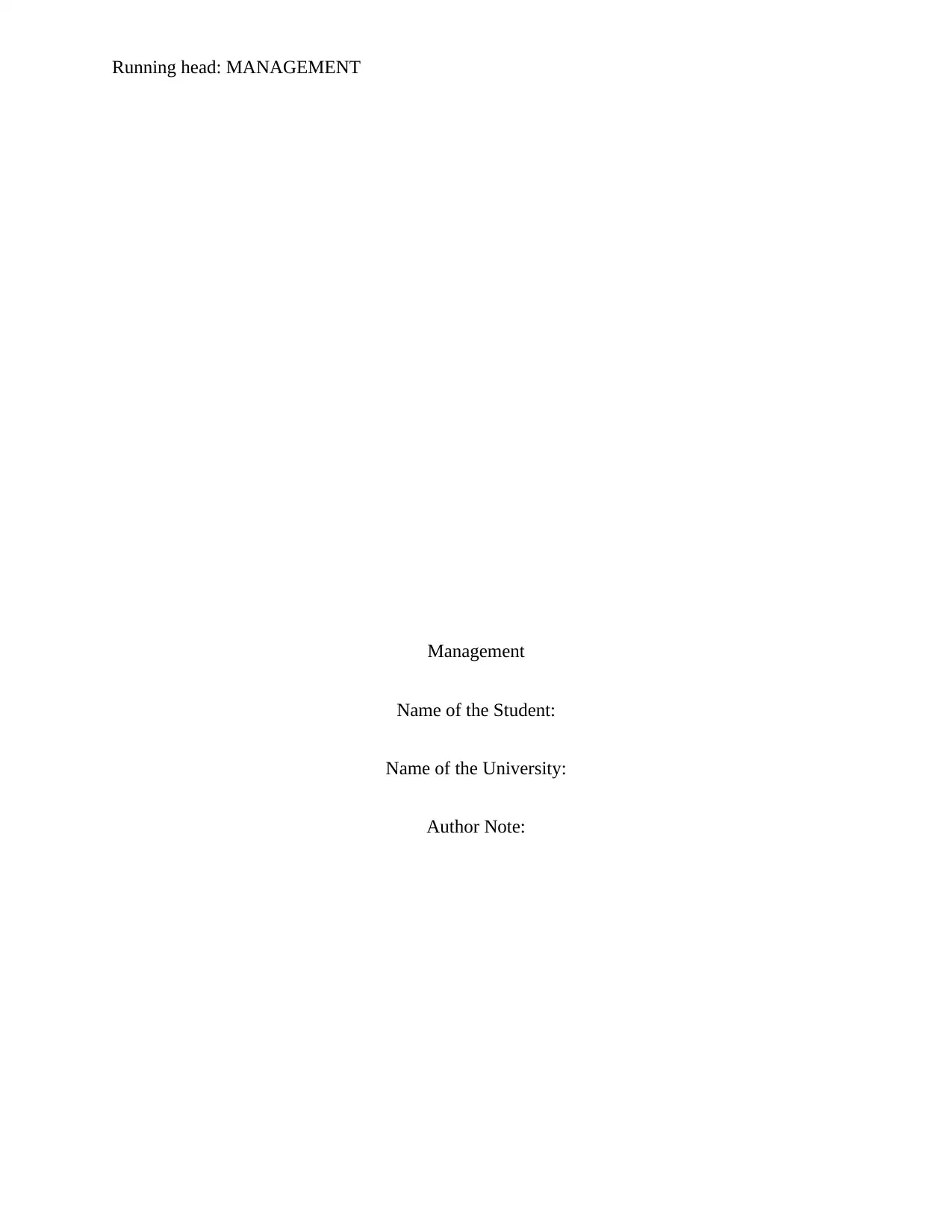
Running head: MANAGEMENT
Management
Name of the Student:
Name of the University:
Author Note:
Management
Name of the Student:
Name of the University:
Author Note:
Paraphrase This Document
Need a fresh take? Get an instant paraphrase of this document with our AI Paraphraser
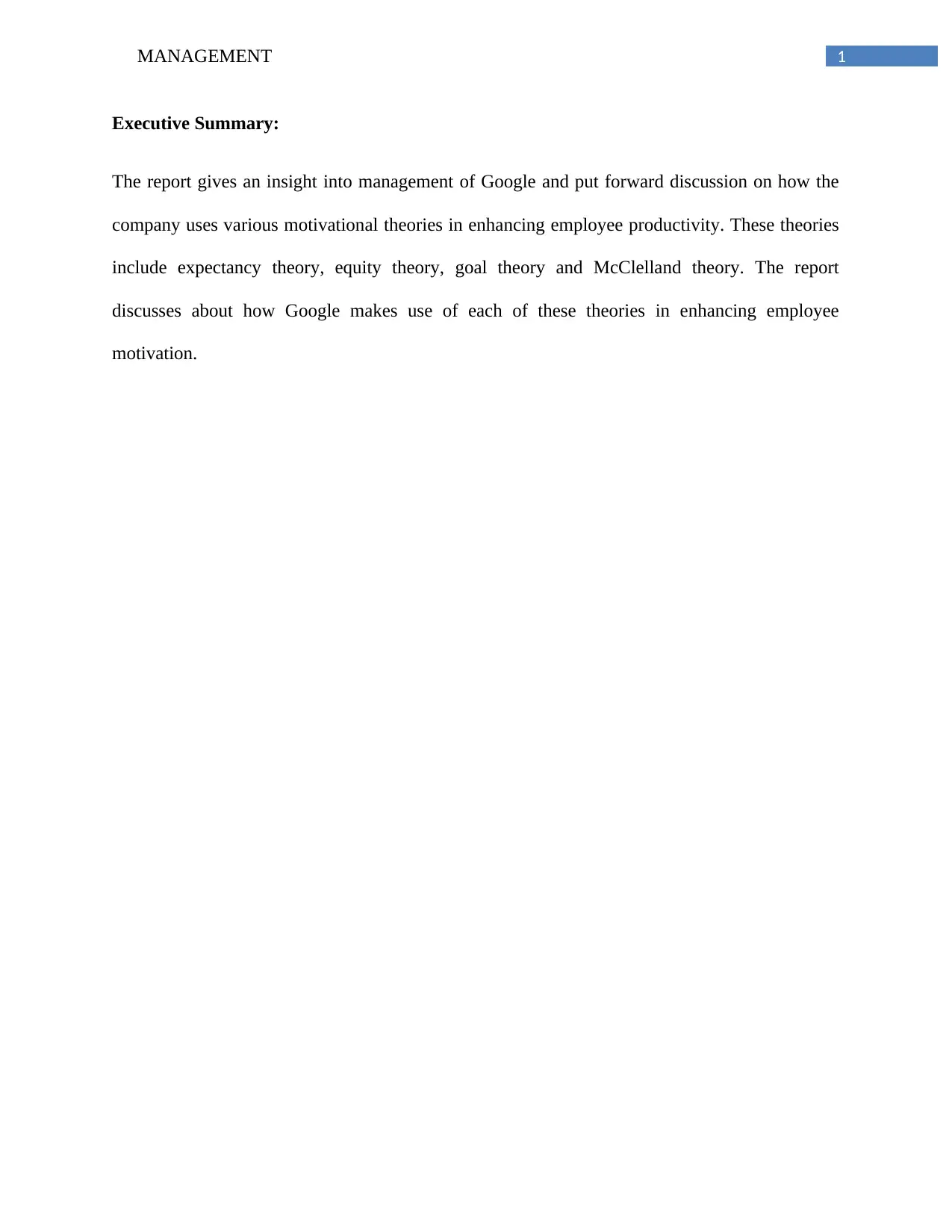
1MANAGEMENT
Executive Summary:
The report gives an insight into management of Google and put forward discussion on how the
company uses various motivational theories in enhancing employee productivity. These theories
include expectancy theory, equity theory, goal theory and McClelland theory. The report
discusses about how Google makes use of each of these theories in enhancing employee
motivation.
Executive Summary:
The report gives an insight into management of Google and put forward discussion on how the
company uses various motivational theories in enhancing employee productivity. These theories
include expectancy theory, equity theory, goal theory and McClelland theory. The report
discusses about how Google makes use of each of these theories in enhancing employee
motivation.
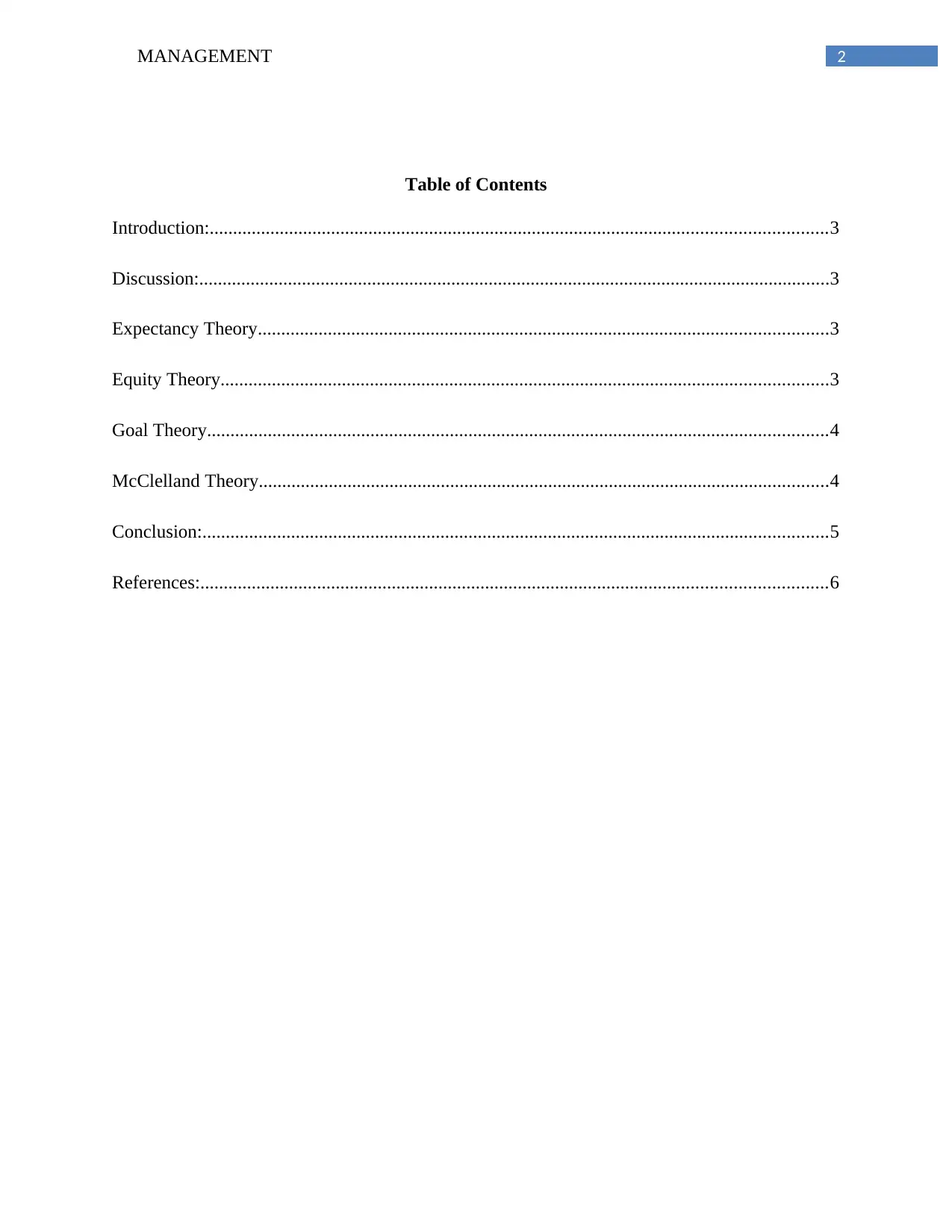
2MANAGEMENT
Table of Contents
Introduction:....................................................................................................................................3
Discussion:.......................................................................................................................................3
Expectancy Theory..........................................................................................................................3
Equity Theory..................................................................................................................................3
Goal Theory.....................................................................................................................................4
McClelland Theory..........................................................................................................................4
Conclusion:......................................................................................................................................5
References:......................................................................................................................................6
Table of Contents
Introduction:....................................................................................................................................3
Discussion:.......................................................................................................................................3
Expectancy Theory..........................................................................................................................3
Equity Theory..................................................................................................................................3
Goal Theory.....................................................................................................................................4
McClelland Theory..........................................................................................................................4
Conclusion:......................................................................................................................................5
References:......................................................................................................................................6
⊘ This is a preview!⊘
Do you want full access?
Subscribe today to unlock all pages.

Trusted by 1+ million students worldwide
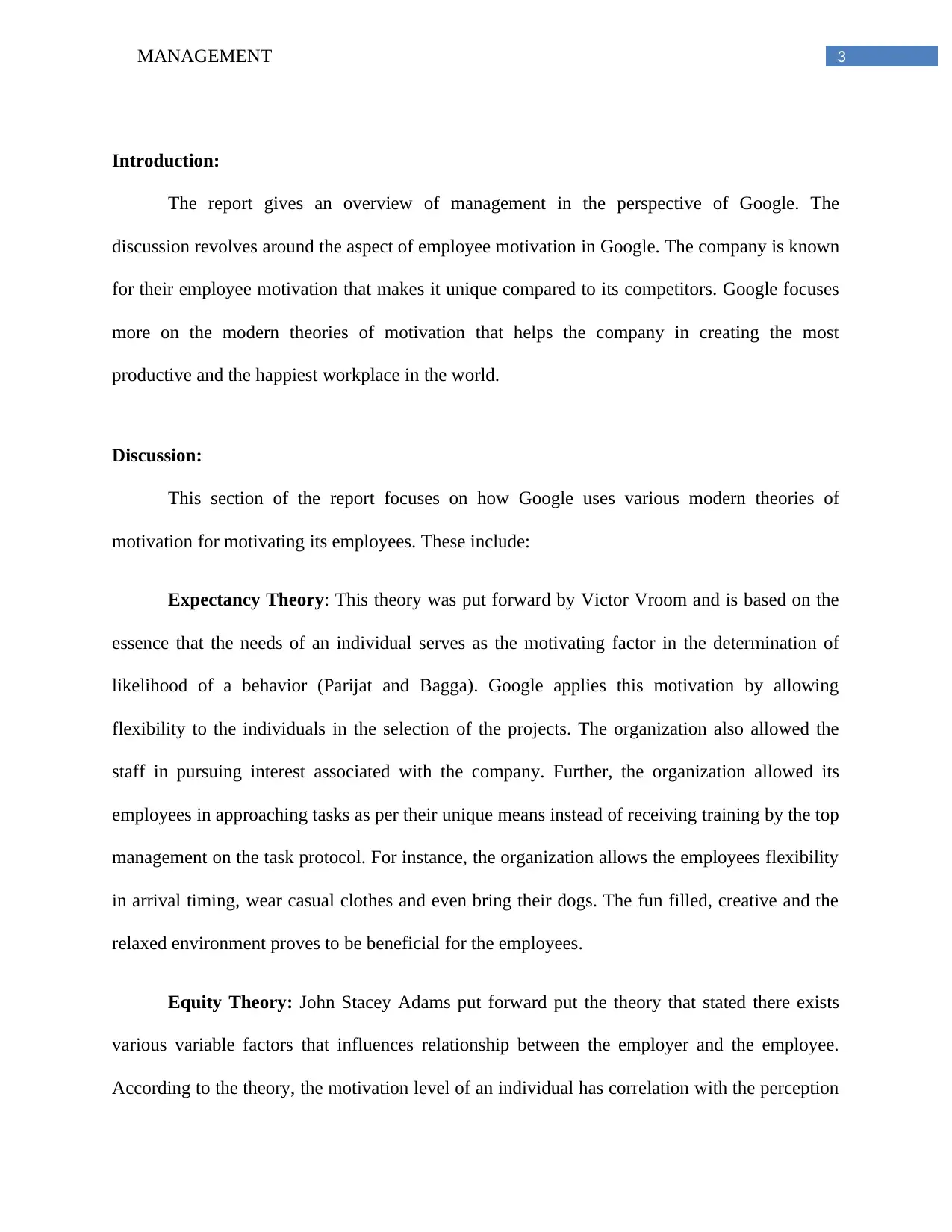
3MANAGEMENT
Introduction:
The report gives an overview of management in the perspective of Google. The
discussion revolves around the aspect of employee motivation in Google. The company is known
for their employee motivation that makes it unique compared to its competitors. Google focuses
more on the modern theories of motivation that helps the company in creating the most
productive and the happiest workplace in the world.
Discussion:
This section of the report focuses on how Google uses various modern theories of
motivation for motivating its employees. These include:
Expectancy Theory: This theory was put forward by Victor Vroom and is based on the
essence that the needs of an individual serves as the motivating factor in the determination of
likelihood of a behavior (Parijat and Bagga). Google applies this motivation by allowing
flexibility to the individuals in the selection of the projects. The organization also allowed the
staff in pursuing interest associated with the company. Further, the organization allowed its
employees in approaching tasks as per their unique means instead of receiving training by the top
management on the task protocol. For instance, the organization allows the employees flexibility
in arrival timing, wear casual clothes and even bring their dogs. The fun filled, creative and the
relaxed environment proves to be beneficial for the employees.
Equity Theory: John Stacey Adams put forward put the theory that stated there exists
various variable factors that influences relationship between the employer and the employee.
According to the theory, the motivation level of an individual has correlation with the perception
Introduction:
The report gives an overview of management in the perspective of Google. The
discussion revolves around the aspect of employee motivation in Google. The company is known
for their employee motivation that makes it unique compared to its competitors. Google focuses
more on the modern theories of motivation that helps the company in creating the most
productive and the happiest workplace in the world.
Discussion:
This section of the report focuses on how Google uses various modern theories of
motivation for motivating its employees. These include:
Expectancy Theory: This theory was put forward by Victor Vroom and is based on the
essence that the needs of an individual serves as the motivating factor in the determination of
likelihood of a behavior (Parijat and Bagga). Google applies this motivation by allowing
flexibility to the individuals in the selection of the projects. The organization also allowed the
staff in pursuing interest associated with the company. Further, the organization allowed its
employees in approaching tasks as per their unique means instead of receiving training by the top
management on the task protocol. For instance, the organization allows the employees flexibility
in arrival timing, wear casual clothes and even bring their dogs. The fun filled, creative and the
relaxed environment proves to be beneficial for the employees.
Equity Theory: John Stacey Adams put forward put the theory that stated there exists
various variable factors that influences relationship between the employer and the employee.
According to the theory, the motivation level of an individual has correlation with the perception
Paraphrase This Document
Need a fresh take? Get an instant paraphrase of this document with our AI Paraphraser
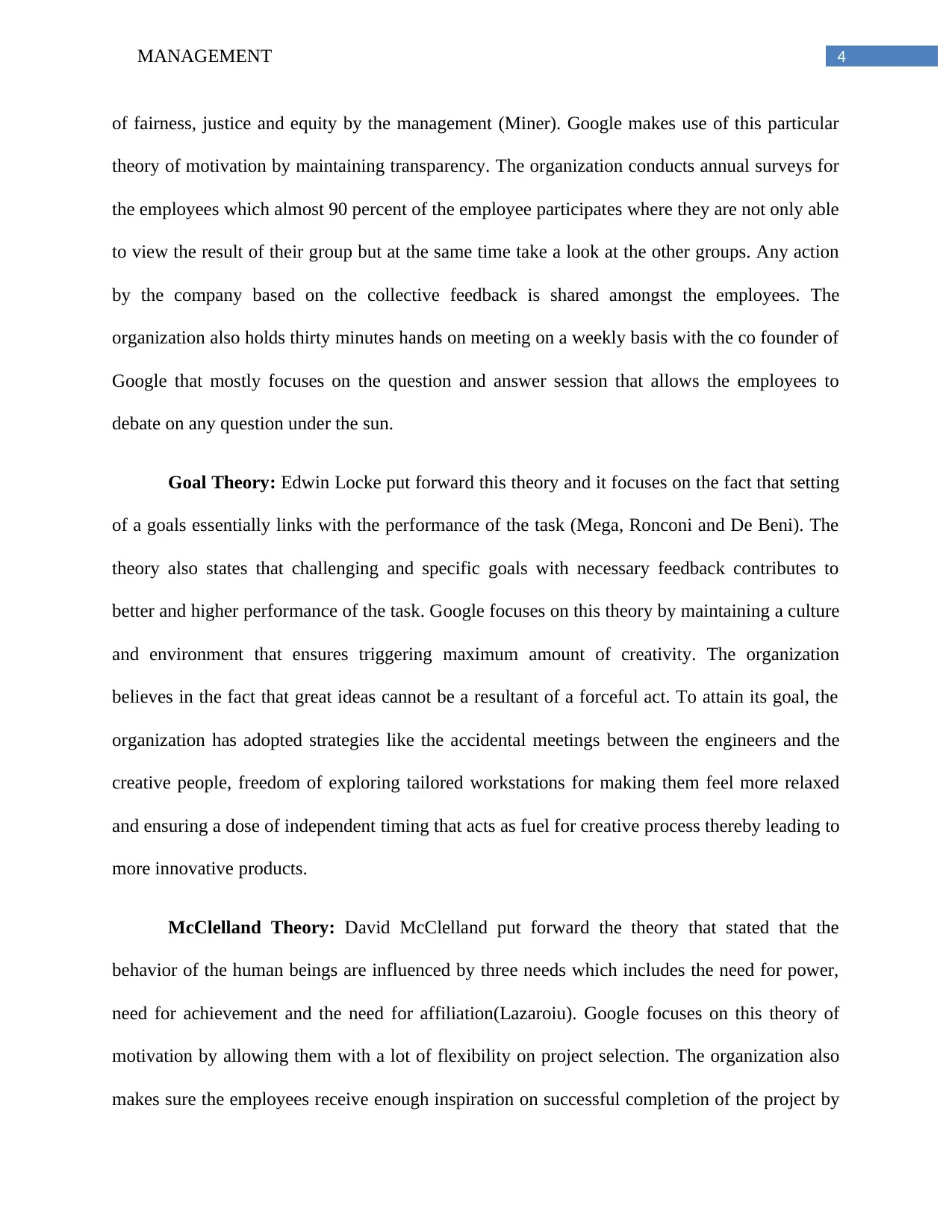
4MANAGEMENT
of fairness, justice and equity by the management (Miner). Google makes use of this particular
theory of motivation by maintaining transparency. The organization conducts annual surveys for
the employees which almost 90 percent of the employee participates where they are not only able
to view the result of their group but at the same time take a look at the other groups. Any action
by the company based on the collective feedback is shared amongst the employees. The
organization also holds thirty minutes hands on meeting on a weekly basis with the co founder of
Google that mostly focuses on the question and answer session that allows the employees to
debate on any question under the sun.
Goal Theory: Edwin Locke put forward this theory and it focuses on the fact that setting
of a goals essentially links with the performance of the task (Mega, Ronconi and De Beni). The
theory also states that challenging and specific goals with necessary feedback contributes to
better and higher performance of the task. Google focuses on this theory by maintaining a culture
and environment that ensures triggering maximum amount of creativity. The organization
believes in the fact that great ideas cannot be a resultant of a forceful act. To attain its goal, the
organization has adopted strategies like the accidental meetings between the engineers and the
creative people, freedom of exploring tailored workstations for making them feel more relaxed
and ensuring a dose of independent timing that acts as fuel for creative process thereby leading to
more innovative products.
McClelland Theory: David McClelland put forward the theory that stated that the
behavior of the human beings are influenced by three needs which includes the need for power,
need for achievement and the need for affiliation(Lazaroiu). Google focuses on this theory of
motivation by allowing them with a lot of flexibility on project selection. The organization also
makes sure the employees receive enough inspiration on successful completion of the project by
of fairness, justice and equity by the management (Miner). Google makes use of this particular
theory of motivation by maintaining transparency. The organization conducts annual surveys for
the employees which almost 90 percent of the employee participates where they are not only able
to view the result of their group but at the same time take a look at the other groups. Any action
by the company based on the collective feedback is shared amongst the employees. The
organization also holds thirty minutes hands on meeting on a weekly basis with the co founder of
Google that mostly focuses on the question and answer session that allows the employees to
debate on any question under the sun.
Goal Theory: Edwin Locke put forward this theory and it focuses on the fact that setting
of a goals essentially links with the performance of the task (Mega, Ronconi and De Beni). The
theory also states that challenging and specific goals with necessary feedback contributes to
better and higher performance of the task. Google focuses on this theory by maintaining a culture
and environment that ensures triggering maximum amount of creativity. The organization
believes in the fact that great ideas cannot be a resultant of a forceful act. To attain its goal, the
organization has adopted strategies like the accidental meetings between the engineers and the
creative people, freedom of exploring tailored workstations for making them feel more relaxed
and ensuring a dose of independent timing that acts as fuel for creative process thereby leading to
more innovative products.
McClelland Theory: David McClelland put forward the theory that stated that the
behavior of the human beings are influenced by three needs which includes the need for power,
need for achievement and the need for affiliation(Lazaroiu). Google focuses on this theory of
motivation by allowing them with a lot of flexibility on project selection. The organization also
makes sure the employees receive enough inspiration on successful completion of the project by
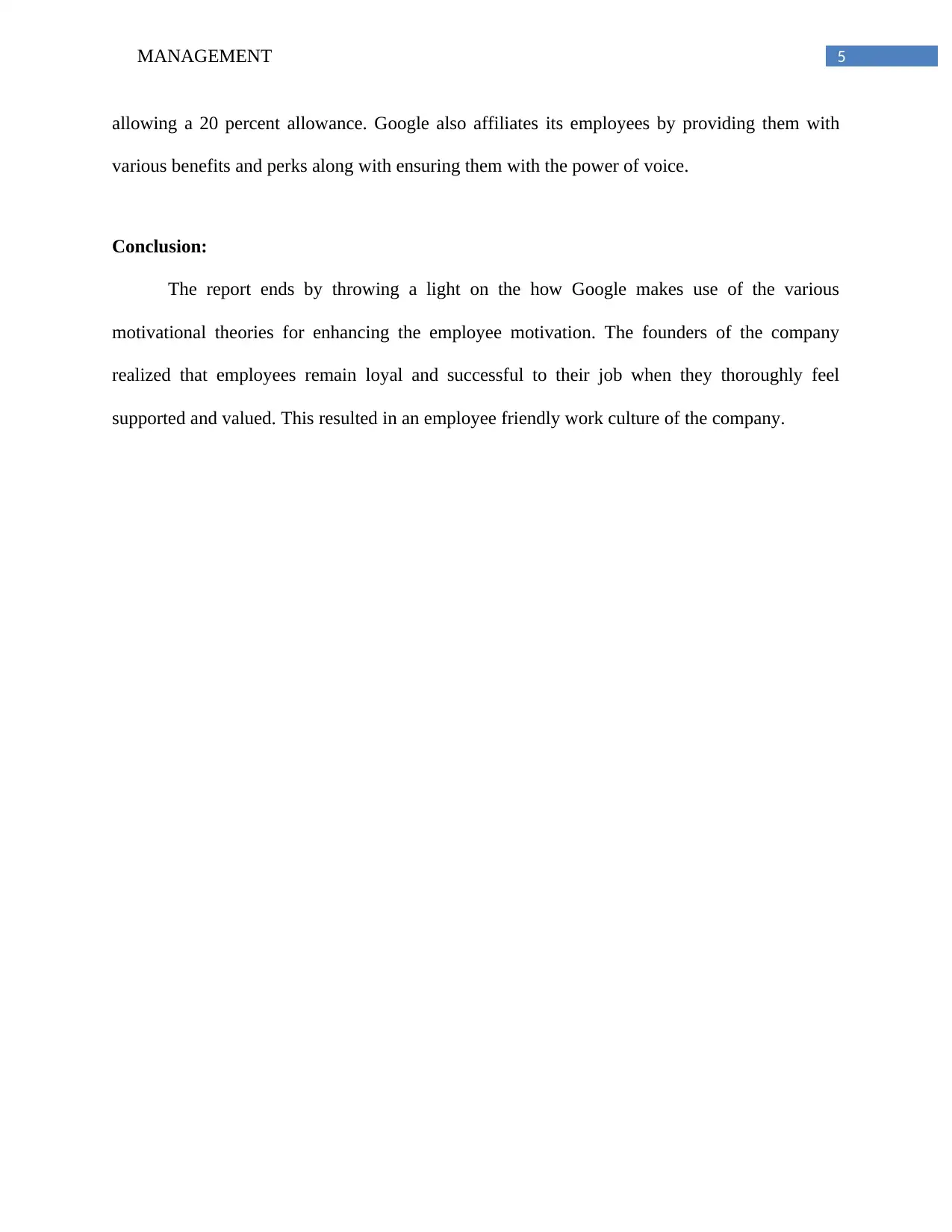
5MANAGEMENT
allowing a 20 percent allowance. Google also affiliates its employees by providing them with
various benefits and perks along with ensuring them with the power of voice.
Conclusion:
The report ends by throwing a light on the how Google makes use of the various
motivational theories for enhancing the employee motivation. The founders of the company
realized that employees remain loyal and successful to their job when they thoroughly feel
supported and valued. This resulted in an employee friendly work culture of the company.
allowing a 20 percent allowance. Google also affiliates its employees by providing them with
various benefits and perks along with ensuring them with the power of voice.
Conclusion:
The report ends by throwing a light on the how Google makes use of the various
motivational theories for enhancing the employee motivation. The founders of the company
realized that employees remain loyal and successful to their job when they thoroughly feel
supported and valued. This resulted in an employee friendly work culture of the company.
⊘ This is a preview!⊘
Do you want full access?
Subscribe today to unlock all pages.

Trusted by 1+ million students worldwide
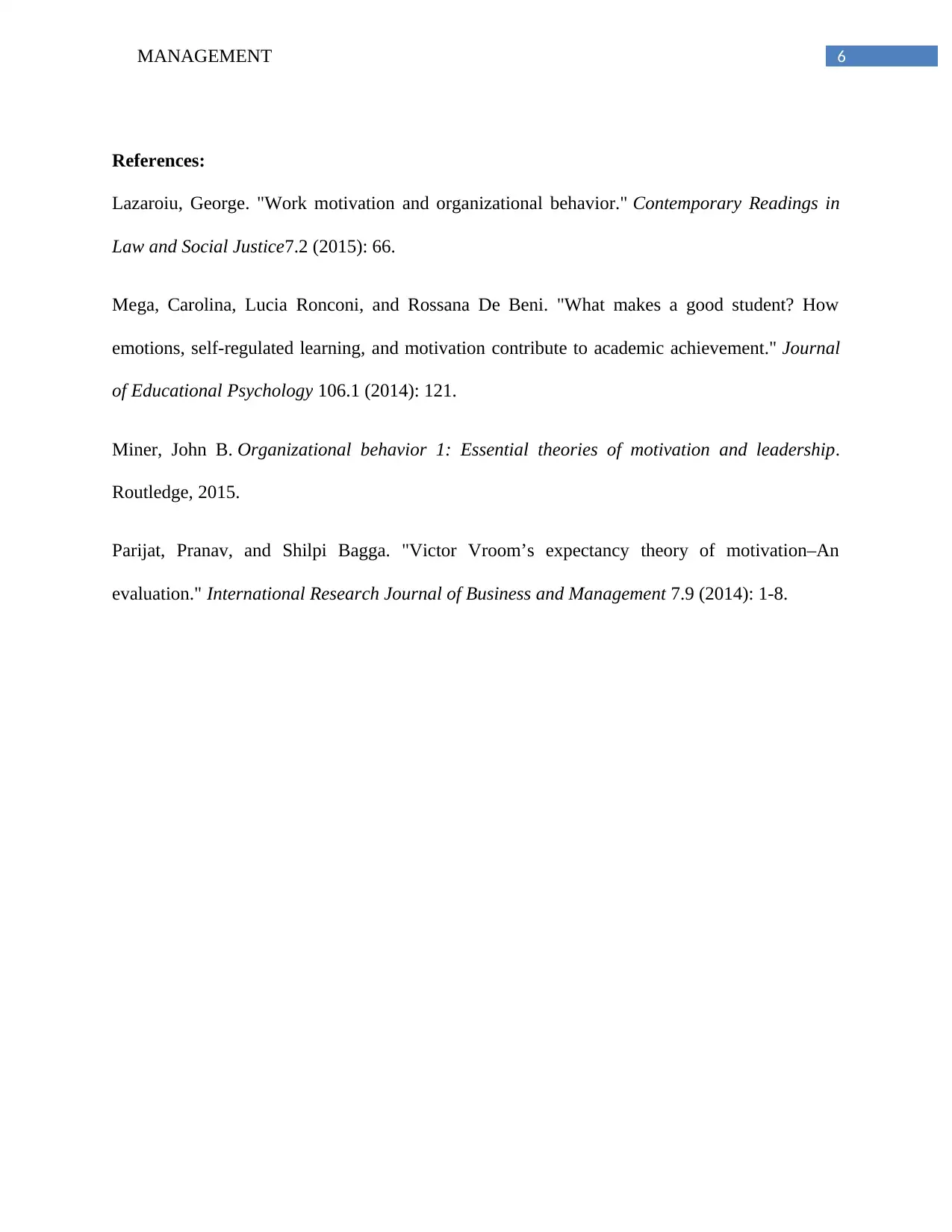
6MANAGEMENT
References:
Lazaroiu, George. "Work motivation and organizational behavior." Contemporary Readings in
Law and Social Justice7.2 (2015): 66.
Mega, Carolina, Lucia Ronconi, and Rossana De Beni. "What makes a good student? How
emotions, self-regulated learning, and motivation contribute to academic achievement." Journal
of Educational Psychology 106.1 (2014): 121.
Miner, John B. Organizational behavior 1: Essential theories of motivation and leadership.
Routledge, 2015.
Parijat, Pranav, and Shilpi Bagga. "Victor Vroom’s expectancy theory of motivation–An
evaluation." International Research Journal of Business and Management 7.9 (2014): 1-8.
References:
Lazaroiu, George. "Work motivation and organizational behavior." Contemporary Readings in
Law and Social Justice7.2 (2015): 66.
Mega, Carolina, Lucia Ronconi, and Rossana De Beni. "What makes a good student? How
emotions, self-regulated learning, and motivation contribute to academic achievement." Journal
of Educational Psychology 106.1 (2014): 121.
Miner, John B. Organizational behavior 1: Essential theories of motivation and leadership.
Routledge, 2015.
Parijat, Pranav, and Shilpi Bagga. "Victor Vroom’s expectancy theory of motivation–An
evaluation." International Research Journal of Business and Management 7.9 (2014): 1-8.
1 out of 7
Related Documents
Your All-in-One AI-Powered Toolkit for Academic Success.
+13062052269
info@desklib.com
Available 24*7 on WhatsApp / Email
![[object Object]](/_next/static/media/star-bottom.7253800d.svg)
Unlock your academic potential
Copyright © 2020–2025 A2Z Services. All Rights Reserved. Developed and managed by ZUCOL.



